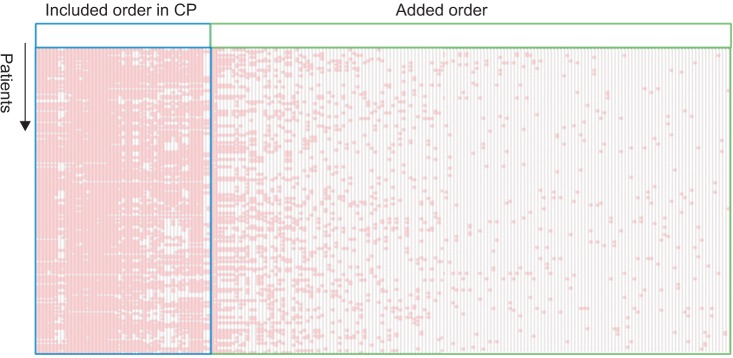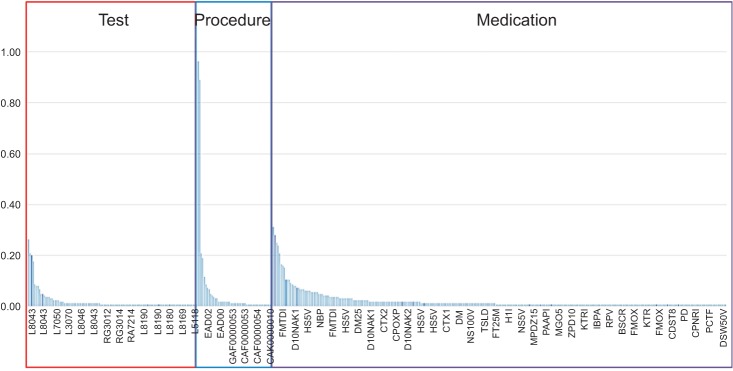Healthc Inform Res.
2015 Jul;21(3):161-166. 10.4258/hir.2015.21.3.161.
Conformance Analysis of Clinical Pathway Using Electronic Health Record Data
- Affiliations
-
- 1Center for Medical Informatics, Seoul National University Bundang Hospital, Seongnam, Korea. yoosoo0@snu.ac.kr
- 2School of Technology Management, Ulsan National Institute of Science and Technology, Ulsan, Korea. msong@unist.ac.kr
- 3Management Innovation Team, Seoul National University Bundang Hospital, Seongnam, Korea.
- 4Department of Obstetrics and Gynecology, Seoul National University Bundang Hospital, Seongnam, Korea.
- KMID: 2125184
- DOI: http://doi.org/10.4258/hir.2015.21.3.161
Abstract
OBJECTIVES
The objective of this study was to confirm the conformance rate of the actual usage of the clinical pathway (CP) using Electronic Health Record (EHR) log data in a tertiary general university hospital to improve the CP by reflecting real-world care processes.
METHODS
We analyzed the application and matching rates of clinicians' orders with predefined CP order sets based on data from 164 inpatients who received appendectomies out of all patients who were hospitalized from August 2013 to June 2014. We collected EHR log data on patient information, medication orders, operation performed, diagnosis, transfer, and CP order sets. The data were statistically analyzed.
RESULTS
The average value of the actual application rate of the prescribed CP order ranged from 0.75 to 0.89. The application rate decreased when the order date was factored in along with the order code and type. Among CP pre-operation, intra-operation, post-operation, routine, and discharge orders, orders pertaining to operations had higher application rates than other types of orders. Routine orders and discharge orders had lower application rates.
CONCLUSIONS
This analysis of the application and matching rates of CP orders suggests that it is possible to improve these rates by updating the existing CP order sets for routine discharge orders to reflect data-driven evidence. This study shows that it is possible to improve the application and matching rates of the CP using EHR log data. However, further research should be performed to analyze the effects of these rates on care outcomes.
Keyword
Figure
Reference
-
1. Rotter T, Kinsman L, James E, Machotta A, Gothe H, Willis J, et al. Clinical pathways: effects on professional practice, patient outcomes, length of stay and hospital costs. Cochrane Database Syst Rev. 2010; (3):CD006632. PMID: 20238347.
Article2. Huang Z, Lu X, Duan H. On mining clinical pathway patterns from medical behaviors. Artif Intell Med. 2012; 56(1):35–50. PMID: 22809825.
Article3. Campbell H, Hotchkiss R, Bradshaw N, Porteous M. Integrated care pathways. BMJ. 1998; 316(7125):133–137. PMID: 9462322.
Article4. Rebuge A, Ferreira DR. Business process analysis in healthcare environments: a methodology based on process mining. Inf Syst. 2012; 37(2):99–116.
Article5. Kimberly J, De Pouvourville G, D'Aunno TA. The globalization of managerial innovation in health care. Cambridge, UK: Cambridge University Press;2008.6. Mans RS, Schonenberg MH, Song M, van der Aalst WM, Bakker PJ. Application of process mining in healthcare-a case study in a Dutch hospital. In : Fred A, Filipe J, Gamboa H, editors. biomedical engineering systems and technologies. Heidelberg, Germany: Springer;2009. p. 425–438.7. Pearson S, Moraw I, Maddern GJ. Clinical pathway management of total knee arthroplasty: a retrospective comparative study. Aust N Z J Surg. 2000; 70(5):351–354. PMID: 10830598.
Article8. Saint S, Hofer TP, Rose JS, Kaufman SR, McMahon LF Jr. Use of critical pathways to improve efficiency: a cautionary tale. Am J Manag Care. 2003; 9(11):758–765. PMID: 14626473.9. Lenz R, Blaser R, Beyer M, Heger O, Biber C, Baumlein M, et al. IT support for clinical pathways: lessons learned. Int J Med Inform. 2007; 76(Suppl 3):S397–S402. PMID: 17567529.10. Huang Z, Dong W, Ji L, Gan C, Lu X, Duan H. Discovery of clinical pathway patterns from event logs using probabilistic topic models. J Biomed Inform. 2014; 47:39–57. PMID: 24076435.
Article11. Huang Z, Dong W, Ji L, Gan C, Lu X, Duan H. Discovery of clinical pathway patterns from event logs using probabilistic topic models. J Biomed Inform. 2014; 47:39–57. PMID: 24076435.
Article12. van de Klundert J, Gorissen P, Zeemering S. Measuring clinical pathway adherence. J Biomed Inform. 2010; 43(6):861–872. PMID: 20696277.
Article13. Chu S, Cesnik B. Improving clinical pathway design: lessons learned from a computerised prototype. Int J Med Inform. 1998; 51(1):1–11. PMID: 9749895.
Article14. Huang Z, Dong W, Duan H, Li H. Similarity measure between patient traces for clinical pathway analysis: problem, method, and applications. IEEE J Biomed Health Inform. 2014; 18(1):4–14. PMID: 24403398.
Article
- Full Text Links
- Actions
-
Cited
- CITED
-
- Close
- Share
- Similar articles
-
- Clinical Terminologies: A Solution for Semantic Interoperability
- Nurses’ Experiences with the Use of Electronic Nursing Record: A Qualitative Study
- Needs Assessment for Functionalities in Electronic Health Record Systems in General Hospitals
- Use of clinical terminology for semantic interoperability of electronic health records
- The Paper-Based Medical Record Compared to the Electronic Medical Record: Documentation and Agreement of Information



